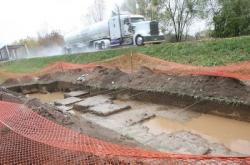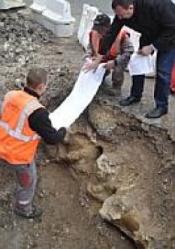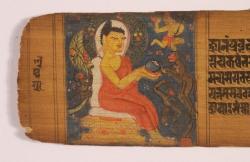08 NOVEMBRE
INDI-UNI : ANTHROPOLOGY - ARCHAEOLOGY
INSCRIPTION 2011 – 2012 COURS A DISTANCE
REGISTRATION 2011 – 2012 ONLINE COURSES
BULGARIE – Shumen - Four archaeological sites have been found on the route of a highway section under construction near the northeastern Bulgarian town of Shumen. Stanimir Stoychev, head of the archaeological research, said that the experts had come across pieces of ceramics from the late Halcolite, the late Bronze Age, the late Iron Age, the Roman period and the early Middle Ages and suggested that the findings were remnants from settlements. Archaeologists said they were hoping that the current case would not be a repeat of the case with the southwestern village of Dren on the Struma highway, where a very rare necropolis dating back to the 7-6 centuries B.C. was destroyed before the Road Infrastructure Agency and archaeologists had managed to wrap up talks on extending the excavations.
http://www.novinite.com/view_news.php?id=133720
USA –  Palmyra - Larry Grantham, an archaeologist with the Missouri Department of Transportation's Environmental Studies and Historic Preservation department, said his team has discovered a pair of Native American sites bookending the Mo. 168 bridge over the North River just west of Palmyra. On the east side of the bridge is a 1,200- to 1,500-year-old site from the late Woodland period. The site on the west side of the bridge, however, is much older -- 3,000 to 5,000 years old, dating to the late Archaic period. More than 3 feet below the ground's surface was evidence of the area's Native American history. Given the differing time periods of the sites, their findings at each have been dramatically different. At the late Woodland site, which dates to roughly AD 650 to 900, the group is looking for evidence of structures on the site. The Native Americans who inhabited that site were much less nomadic than earlier peoples, Grantham said. "By the late Woodland (period), they're building houses, and they're being semi-sedentary," Grantham said. He said cooking pits and storage pits also are likely to turn up. The late Archaic site, which dates to roughly 3000 to 1000 BC, is yielding more of the artifacts that traditionally are associated with Native American digs. The archaeologists are hand-digging the site in 3-foot squares of just a few inches' depth. Among the artifacts the archaeologists have turned up are projectile points, drills and other tools, all made from chert, a type of rock found along the Mississippi River. That suggests to Grantham that the late Archaic inhabitants moved around the northern half of Missouri in a seasonal cycle, returning to Northeast Missouri for a short time to pick up their weapons materials. Chert wouldn't have been found in most of the interior of northern Missouri.
Palmyra - Larry Grantham, an archaeologist with the Missouri Department of Transportation's Environmental Studies and Historic Preservation department, said his team has discovered a pair of Native American sites bookending the Mo. 168 bridge over the North River just west of Palmyra. On the east side of the bridge is a 1,200- to 1,500-year-old site from the late Woodland period. The site on the west side of the bridge, however, is much older -- 3,000 to 5,000 years old, dating to the late Archaic period. More than 3 feet below the ground's surface was evidence of the area's Native American history. Given the differing time periods of the sites, their findings at each have been dramatically different. At the late Woodland site, which dates to roughly AD 650 to 900, the group is looking for evidence of structures on the site. The Native Americans who inhabited that site were much less nomadic than earlier peoples, Grantham said. "By the late Woodland (period), they're building houses, and they're being semi-sedentary," Grantham said. He said cooking pits and storage pits also are likely to turn up. The late Archaic site, which dates to roughly 3000 to 1000 BC, is yielding more of the artifacts that traditionally are associated with Native American digs. The archaeologists are hand-digging the site in 3-foot squares of just a few inches' depth. Among the artifacts the archaeologists have turned up are projectile points, drills and other tools, all made from chert, a type of rock found along the Mississippi River. That suggests to Grantham that the late Archaic inhabitants moved around the northern half of Missouri in a seasonal cycle, returning to Northeast Missouri for a short time to pick up their weapons materials. Chert wouldn't have been found in most of the interior of northern Missouri.
http://www.whig.com/story/news/Palmyra-Archaeological-Dig-110711
FRANCE –  Cambrai - À l'origine de la découverte se trouve un chantier de remise aux normes du réseau d'eau pluviale dans Cambrai. Didier est grutier. « Quand on travaille comme ça en ville, on terrasse doucement, parce qu'il y a plein d'autres réseaux, explique le spécialiste. Et quand on tape sur quelque chose de dur, on le sent tout de même ». Et la première chose dure en question, c'est une pierre moulurée. Peu après, un maçon de l'équipe, Philippe, descendu dans l'excavation, ne tarde pas à découvrir l'extrémité du pied : il aperçoit des orteils ! Les travaux à cet endroit sont aussitôt stoppés. La « mise au propre » de la tranchée va vite mettre en évidence (au moins) trois superbes blocs sculptés. L'ensemble est à peine enterré à moins de 30 cm sous les pavés. Le premier est « un pied à l'antique, gainé dans un bottillon, avec un simulacre de repli en cuir », explique Philippe Gantiez, présent sur les lieux. On distingue nettement, à côté, « une superbe gueule d'animal terrassé ». Annie Lefebvre et Florence Albaret, respectivement guide conférencière et directrice des Affaires culturelles, avancent l'hypothèse de la représentation d'un démon. Et du coup, on se plaît à imaginer que ce pied pourrait être celui de Saint Georges ou de Saint Michel... Le deuxième bloc est très énigmatique, « non interprétable en l'état ». On y voit ce qui semble être un oeil. Éventuellement une corne en dessous... « Il n'a vraisemblablement rien à voir avec les deux autres », avance Florence Albaret. De fait, le morceau de droite et celui de gauche pourraient provenir de la même oeuvre. Ils semblent d'ailleurs de la même couleur. Il s'agit de calcaire local. Le morceau central est différent, jusque dans sa sculpture, son « inspiration ». Enfin, le troisième morceau, visiblement le plus imposant et dont une bonne partie reste ensevelie sous la chaussée, est « un buste sculpté en pli lissé ». À son espèce de cuirasse, d'armure, on imagine un soldat, peut-être romain. Les trois pièces ont été posées sur un même socle en calcaire. Les spécialistes sur place osent une datation : « Fin Moyen Âge, sans doute XVIe siècle », pour les deux morceaux « communs » « bien plus ancien », pour celui « central ». Cependant, aussi superbes qu'aient été ces oeuvres, elles ont bien été mises là pour servir de remblais, « pour bloquer quelque chose ».
Cambrai - À l'origine de la découverte se trouve un chantier de remise aux normes du réseau d'eau pluviale dans Cambrai. Didier est grutier. « Quand on travaille comme ça en ville, on terrasse doucement, parce qu'il y a plein d'autres réseaux, explique le spécialiste. Et quand on tape sur quelque chose de dur, on le sent tout de même ». Et la première chose dure en question, c'est une pierre moulurée. Peu après, un maçon de l'équipe, Philippe, descendu dans l'excavation, ne tarde pas à découvrir l'extrémité du pied : il aperçoit des orteils ! Les travaux à cet endroit sont aussitôt stoppés. La « mise au propre » de la tranchée va vite mettre en évidence (au moins) trois superbes blocs sculptés. L'ensemble est à peine enterré à moins de 30 cm sous les pavés. Le premier est « un pied à l'antique, gainé dans un bottillon, avec un simulacre de repli en cuir », explique Philippe Gantiez, présent sur les lieux. On distingue nettement, à côté, « une superbe gueule d'animal terrassé ». Annie Lefebvre et Florence Albaret, respectivement guide conférencière et directrice des Affaires culturelles, avancent l'hypothèse de la représentation d'un démon. Et du coup, on se plaît à imaginer que ce pied pourrait être celui de Saint Georges ou de Saint Michel... Le deuxième bloc est très énigmatique, « non interprétable en l'état ». On y voit ce qui semble être un oeil. Éventuellement une corne en dessous... « Il n'a vraisemblablement rien à voir avec les deux autres », avance Florence Albaret. De fait, le morceau de droite et celui de gauche pourraient provenir de la même oeuvre. Ils semblent d'ailleurs de la même couleur. Il s'agit de calcaire local. Le morceau central est différent, jusque dans sa sculpture, son « inspiration ». Enfin, le troisième morceau, visiblement le plus imposant et dont une bonne partie reste ensevelie sous la chaussée, est « un buste sculpté en pli lissé ». À son espèce de cuirasse, d'armure, on imagine un soldat, peut-être romain. Les trois pièces ont été posées sur un même socle en calcaire. Les spécialistes sur place osent une datation : « Fin Moyen Âge, sans doute XVIe siècle », pour les deux morceaux « communs » « bien plus ancien », pour celui « central ». Cependant, aussi superbes qu'aient été ces oeuvres, elles ont bien été mises là pour servir de remblais, « pour bloquer quelque chose ».
http://www.lavoixdunord.fr/Locales/Cambrai/actualite/Cambrai/2011/11/08/article_une-decouverte-archeologique-de-taille-e.shtml
INDE –  Some 2,000 rare Sanskrit manuscripts detailing momentous political and economic events across south Asia and written on fragile birch bark, palm leaf and paper are to form part of a major project undertaken by Cambridge University to document ancient civilisations by studying the language of the time, officially known as “linguistic archaeology”. The documents, which belong to Cambridge University Library’s South Asian manuscript collection, will be studied individually and catalogued placing them in their broader historical context. They will also be digitised and put on the library’s new online service.
Some 2,000 rare Sanskrit manuscripts detailing momentous political and economic events across south Asia and written on fragile birch bark, palm leaf and paper are to form part of a major project undertaken by Cambridge University to document ancient civilisations by studying the language of the time, officially known as “linguistic archaeology”. The documents, which belong to Cambridge University Library’s South Asian manuscript collection, will be studied individually and catalogued placing them in their broader historical context. They will also be digitised and put on the library’s new online service.
http://www.thehindu.com/news/international/article2609448.ece
BELIZE - The scientists have revealed how Maya lowlands, which were one of the most densely populated areas in the world during ancient Maya Classic period (250 - 900 AD), sustained its population. The archaeologists have estimated that, even in places such as the southern Maya Mountains area of Belize where geographic and other environmental conditions could be assumed to have mitigated population growth, population density was estimated at approximately 300 persons per square kilometer at one time, Popular Archaeology reported. Recent studies by a team of researchers from Cleveland State University, University of Nevada and the PaleoResearch Institute, along with Q'eqchi Maya bushmasters and Q'eqchi Maya traditional healers in the field, have shed new light on how they may have done it, and how they kept their people healthy. By taking and analyzing soil samples and microscopic phytoliths from Classic Maya archaeological sites in Belize, coupled with ethnographic data drawn from living Maya groups, a team of researchers have discovered evidence that could reveal clues to a sustainable agricultural strategy used by them. The team took into consideration soil samples from excavations conducted at three Classic Maya sites. The study found that the excavated layers or strata from the terraces at Sahonak Tasar revealed a practice of intense cultivation that involved management and diversion of rich soil runoff from the higher elevations, and alternate growing, burning, and flooding, a technique that, while growing the needed plants, also enriched the soil. They also revealed that the ancients were growing a myriad of both nutritional and medicinal plants within the same terraced area, in contrast to the mono-cropping, or single crop, model often cited in literature about Maya agricultural practices. The study also suggested that the ancients grew and processed a variety of plants close to their homes (such as in household gardens) that were high in nutritional and medicinal value.
http://zeenews.india.com/news/eco-news/how-maya-lowlands-supported-dense-population_740675.html